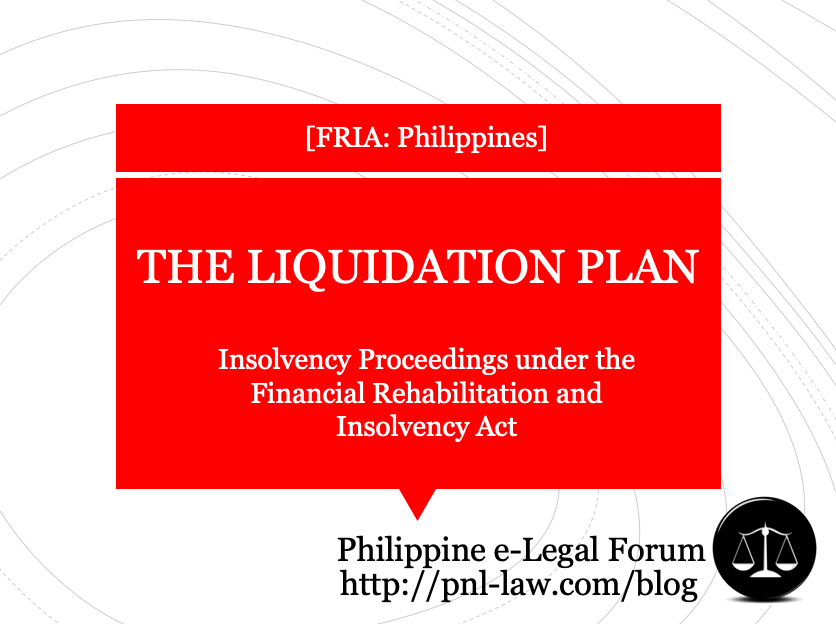Insolvency proceedings may refer to voluntary or involuntary proceedings for individual debtors(see Voluntary or involuntary liquidation) or juridical entities (see Liquidation proceedings). The rules on determination of claims are common in all these proceedings, as provided under Republic Act No. 10142, also known as the “Financial Rehabilitation and Insolvency Act (FRIA) of 2010”, and fleshed out in the FLSP Rules. For purposes of these common provisions, the term “debtor” includes individual debtors and other juridical debtors.

| Other common provisions: * Avoidance Proceedings * Determination of claims * Jurisdiction and nature of proceedings | * The Liquidation Order * The Liquidator * Secured creditors |
THE LIQUIDATION PLAN
Within 3 months from his assumption into office, the liquidator shall submit a Liquidation Plan to the court. The Liquidation Plan shall, as a minimum:
- (b) include a list of all creditors and their claims which have been duly proved as shown in the final registry of claims, and
- (c) include a proposed mode and schedule of liquidation of the assets and payment of the claims.
The Liquidation Plan shall make provisions for, among others, disputed claims and any action for rescission or nullity of certain transactions.
EXEMPT PROPERTY TO BE SET APART
Upon motion, and after notice and hearing, the court shall set apart property of the individual debtor exempt from execution. The motion shall be heard and granted only after it is shown that the clerk of court has posted or caused notice of the motion and hearing in at least 3 public places in the province or city where the court exercises jurisdiction at least 10 days prior to the time of such hearing, which notice shall set forth the name of the debtor, and the time and place appointed for the hearing of such motion, and shall briefly indicate the homestead sought to be exempted or the property sought to be set aside.
CONCURRENCE AND PREFERENCE OF CREDITS
The Liquidation Plan and its implementation shall ensure that the concurrence and preference of credits as enumerated in the Civil Code of the Philippines, and other relevant laws, shall be observed, unless a preferred creditor voluntarily waives his preferred right. Credits for services rendered by employees or laborers to the debtor shall enjoy first preference under Article 2244 of the Civil Code, unless the claims constitute legal liens under Articles 2241 and 2242 thereof.
SALE OF ASSETS IN LIQUIDATION
With the approval of the court, the liquidator may sell, transfer or otherwise dispose of the unencumbered assets of the debtor and convert the same into money. The sale, transfer or disposition shall be made at public auction. However, a private sale, transfer or disposition may be allowed with the approval of the court if:
- (a) the goods to be sold are of a perishable nature, or are liable to quickly deteriorate in value, or are disproportionately expensive to keep or maintain; or
- (b) the private sale, transfer or disposition is for the best interest of the debtor and his creditors.
With the approval of the court, unencumbered property of the debtor may also be conveyed to a creditor in satisfaction of his claim or part thereof. In all cases, the liquidator and the court shall ensure that the manner of sale, transfer or disposition is in the best interest of the debtor and his creditors.
MANNER OF IMPLEMENTING THE LIQUIDATION PLAN
The liquidator shall implement the Liquidation Plan as approved by the court in an order duly issued therefor. Payments shall be made to creditors only in accordance with the provisions of the Plan.
FINAL REPORT OF THE LIQUIDATOR
When all the property of the debtor not exempt from execution have been realized and their proceeds distributed to the creditors in accordance with the Liquidation Plan, the liquidator shall submit his final report to the court, together with the final accounting of his administration and a recommendation for the termination of the proceedings, furnishing all the creditors and other interested parties with copies thereof.
TERMINATION OF PROCEEDINGS
If, after notice and hearing, the court is satisfied with the final report, it shall issue an order approving the same and directing the removal of the name of the juridical debtor from the register of legal entities of the SEC and other government agencies, or discharging the individual debtor from his liabilities included in the Liquidation Plan, as the case may be.
In the same order discharging the individual debtor from his liabilities, the court shall state that the proceedings are terminated. However, in the case of a juridical debtor registered with the SEC, the court shall issue an order terminating the proceedings only upon receipt of evidence showing that the debtor has been removed from the registry of legal entities at the SEC.
LIQUIDATION OF A SECURITIES MARKET PARTICIPANT
The foregoing provisions shall be without prejudice to the power of a regulatory agency or self-regulatory organization to liquidate trade-related claims of clients or customers of a securities market participant which, for purposes of investor protection, are hereby deemed to have absolute priority over other claims of whatever nature or kind insofar as trade-related assets are concerned.
For purposes of this section, trade-related assets include cash, securities, trading right, and other assets owned and used by the securities market participant in the ordinary course of its business.
- Extension of Filing Periods and Suspension of Hearings for March 29 to April 4, 2021: SC Administrative Circular No. 14-2021 (Full Text) - March 28, 2021
- ECQ Bubble for NCR, Bulacan, Cavite, Laguna and Rizal: Resolution No. 106-A (Full Text) - March 27, 2021
- Guidelines on the Administration of COVID-19 Vaccines in the Workplaces (Labor Advisory No. 3) - March 12, 2021
